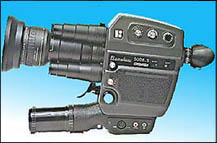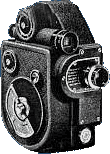 | |||||
 |  | ||||
VIDEO TRANSFER: If you've shot your 8mm film and now want to transfer it to video or computerized non-linear editing system, then you have a few options to consider. The cheapest way is to project your film onto a screen and record the image using a video camera. To do this you'll need to project the film using a variable speed projector. The variable speed projector helps you eliminate the flicker because film projects at 24 frames per second and video works at 30. You'll also need a screen to project it on as well as a tripod to keep your camera steady during the transfer. TRANSFER DETAILS: When you setup and get ready to transfer you'll need to do a manual white balence on your camcorder or video camera. You need to do a manual white balence to avoid the camera changing colour balence through the film. Also put your camera focus and exposure features on manual. This will help you get a consistant transfer image from shot to shot. The quality of this type of transfer is not that great but you can use edit the videotaped image and predict what it will look like if you eventually decide to cut and edit the film itself.
HIGH QUALITY TRANSFER :If you want a much higher quality transfer then you should go to a professional post-production facility and get it transfered there. Remember this procedure is not cheap. It costs about $250-$300 for every hour of transfer. You get to sit with the colourist and decide if the colour of the film is right for you. If you've shot something worthwhile then this type of transfer is definately the way to go. VIDEO AND NLE EDITING :Now that your film has been transfered, you have to decide if you want to do linear or non-linear editing. If you do simple non-linear editing then you shouldn't have any problems with a normal editing suite. But if you want to do computerized non-linear editing you'll need special equipment. VIDEO CAPTURE TECHNOLOGY:The cheapest way to capture video onto a non-linear suite is through your pc. You can purchase a good video capture card and download your transfered film from a VCR. A company with a good video card is PINNACLE. They sell all kinds of great products for video capture. I definately recommend going to them. In terms of computer requirements, make sure you have at least 2GB partitioned on a defragmented hard disk for output storage. VIDEO TO PC STORAGE: Remember that video capture quality also determines the final quality of your project. You can capture your film/video to the computer at varying resolutions. To give you an idea of the memory space required by your computer we're going to give you an example. For a 2min and 20 sec video it took about 175 MB of space for an AVI file at 320 X 240 resolution. To help, you should think about investing in a CD burner as an alternative method of storage. Cds have 650megs of space and JAZZ drives have 1 or 2 gigs of space. But don't buy a jazz drive because they tend to break down quite easily. Instead, CDs and Zip disks are much more durable and reliable. | | ||||
 |  | ||||
   |
 | | RIVALQUEST | E-MAIL | |  | ||
| ||||

